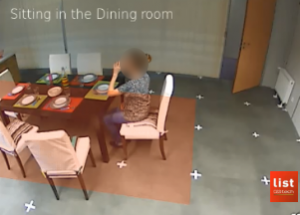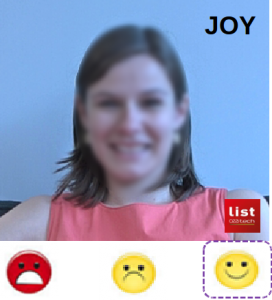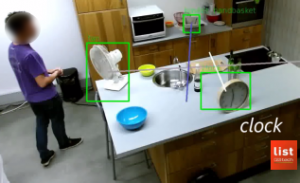-
Research at CEA LIST : Examples of Human Behaviour research topics
Daily activity understanding

 Affective ComputingUser / Environment Interactions
Affective ComputingUser / Environment Interactions

-
Realistic datasets
DAHLIA (DAily Human Life Activity)
DAHLIA dataset is devoted to human activity recognition, which is a major issue for adapting smart-home services such as user assistance.
DAHLIA has been realized in Mobile Mii Platform by CEA LIST, and has been partly supported by ITEA 3 Emospaces Project (https://itea3.org/project/emospaces.html)
DALHIA has been published at the 12th IEEE Conference on Automatic Face & Gesture Recognition, Washington DC, USA, May 31th – 3rd June, 2017. See Paper here
Videos were recorded in realistic conditions, with 3 Kinect v2 sensors located as they would be in a real context. The long-range activities were performed in an unconstrained way (participants received only few instructions), and in a continuous (untrimmed) sequence, resulting in long videos (40 min in average per subject). Contrary to previously published databases, in which labeled actions are very short and have low-semantic level, this new database focuses on high-level semantic activities such as « Preparing lunch » or « House Working ».
DAHLIA Datafile Package:
The dataset is devided into two sets:
– set1: 25 examples
– set2: 26 examples
The tree structure and content of directories is done as below:
S01_A1/
Label/
S01_A1_K1/
S01_A1_K2/
S01_A1_K3/
Color/
Depth/
Time/
Body/
BodyIndex.7z
In each examples, you will find the directories for each stream of the three cameras and the Label directory which is common to all views.
- Label : The xml files with activity label for each frames.
Activities are : Cooking (id: 1) – Laying table (2) – Eating (3) – Clearing Table (4) – Washing dishes (5) – Housework (6) – Working (7) – Neutral (0) - Color : The RGB avi video file
- Depth : The jpg2000 files corresponding to depth map
- Time : The timestamp files
- Body : The csv files with skeleton 3D coordinates.
Fileskeleton.csv: expressed in depth map referential. FileskeletonSkSpace.csv: expressend in real world referential. - BodyIndex.7z : (when extracted,) The body index binaries files which can be decoded in tif files thanks to the C++ software: https://github.com/CEA-LIST/DAHLIA-BodyIndex
You will then obtain a black and white image correponding to the body index returned by the Kinect v2.
Benchmark on DAHLIA:
| Benchmark | |||||||||||||||
|---|---|---|---|---|---|---|---|---|---|---|---|---|---|---|---|
| Skeleton based | |||||||||||||||
| View 1 | View 2 | View 3 | Multi-View | Cross-View | |||||||||||
| FA1 | F-Score | IoU | FA1 | F-Score | IoU | FA1 | F-Score | IoU | FA1 | F-Score | IoU | FA1 | F-Score | IoU | |
| DOHT | 0.60 | 0.58 | 0.42 | 0.63 | 0.60 | 0.44 | 0.73 | 0.71 | 0.56 | 0.65 | 0.64 | 0.48 | 0.34 | 0.31 | 0.19 |
| ELS | 0.18 | 0.18 | 0.11 | 0.27 | 0.26 | 0.16 | 0.52 | 0.55 | 0.39 | 0.31 | 0.32 | 0.21 | |||
| Color based | |||||||||||||||
| View 1 | View 2 | View 3 | Multi-View | Cross-View | |||||||||||
| FA1 | F-Score | IoU | FA1 | F-Score | IoU | FA1 | F-Score | IoU | FA1 | F-Score | IoU | FA1 | F-Score | IoU | |
| DOHT | 0.80 | 0.77 | 0.64 | 0.81 | 0.79 | 0.66 | 0.80 | 0.77 | 0.65 | 0.85 | 0.82 | 0.71 | |||
| Max Subgraph Search | 0.25 | 0.15 | 0.18 | 0.10 | 0.44 | 0.31 | |||||||||
| Sub Activity | 0.85 | 0.81 | 0.73 | 0.87 | 0.82 | 0.75 | 0.82 | 0.76 | 0.69 | 0.85 | 0.82 | 0.71 | |||
If you have published results of activity recognition on the DAHLIA dataset, please send us an eMail (dahlia.mobilemii@cea.fr) with a link to your official publication in order to update the benchmark table.
Dataset Request Formular:
Please download the formular, fulfill, sign and send it by eMail to : dahlia.mobilemii@cea.fr
Once we received your fulfiled request, download instructions will be sent to you back.